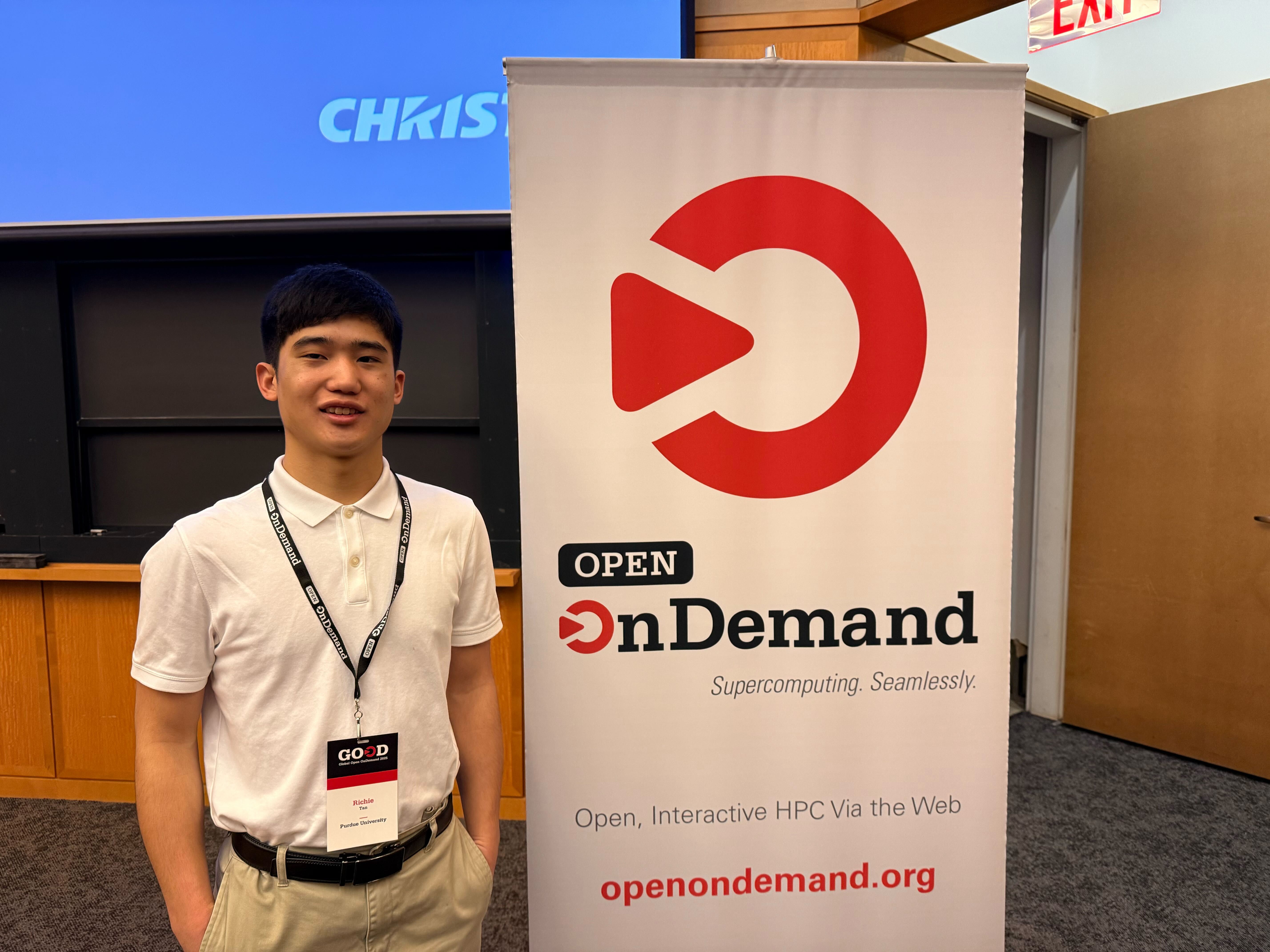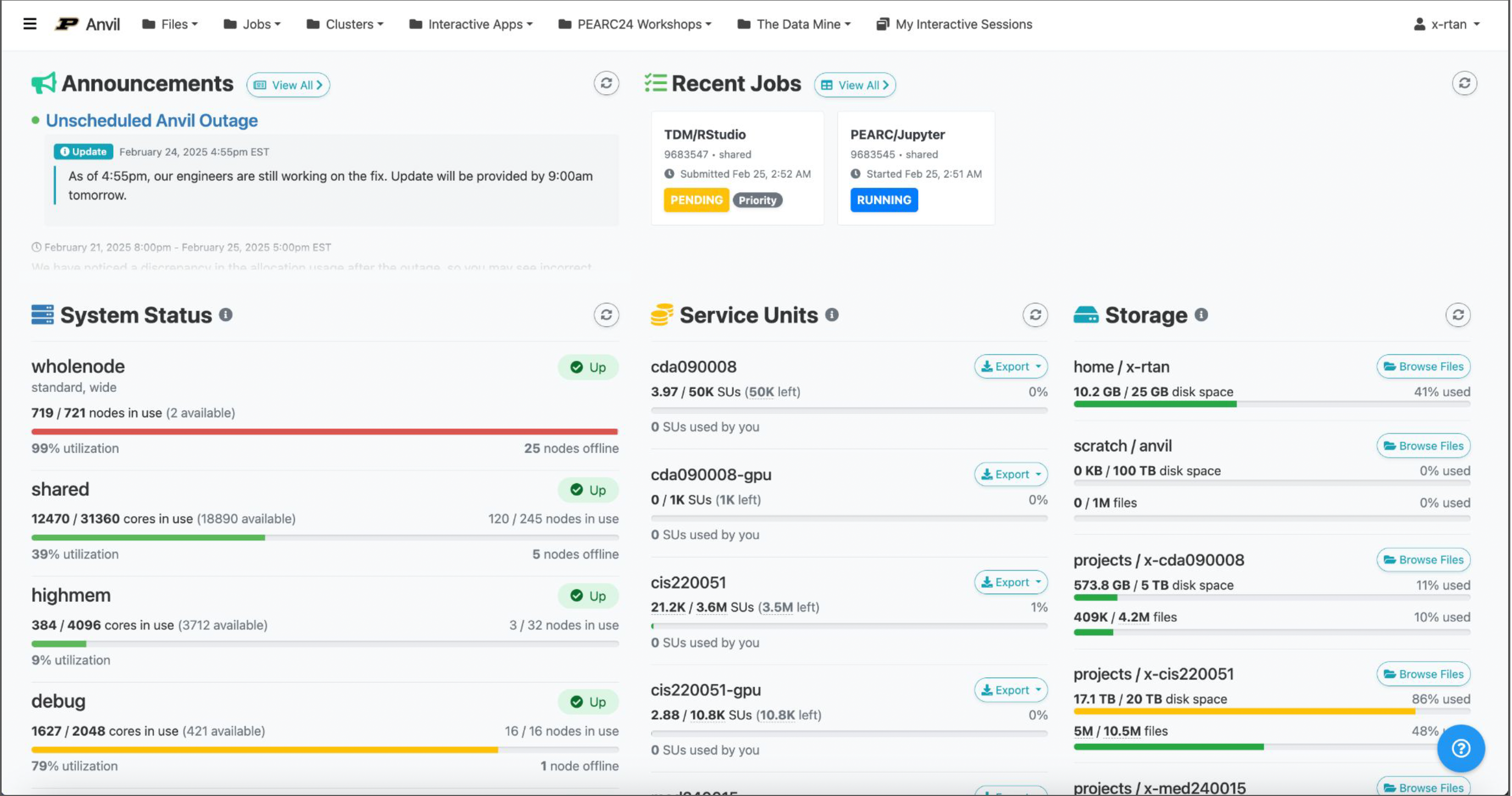Anvil REU Student presents at GOOD 2025
Richie Tan, one of the participants of the Rosen Center for Advanced Computing’s (RCAC) 2024 Anvil Research Experience for Undergraduates (REU) Summer program, recently presented at the Global Open OnDemand 2025 Conference (GOOD 2025). Tan highlighted the web dashboard that he and another REU student, Anjali Rajesh, developed during the summer program. The web dashboard went live on the Anvil supercomputer in January of 2025 and has been an enormous hit with Anvil users since going into production.
Richie Tan is an  undergraduate studying Computer Science at Purdue University. He, along with seven other students from across the nation, was accepted into the highly competitive 2024 Anvil REU summer program, where he had the opportunity to participate in an 11-week hands-on internship. During the program, the eight students learned about high-performance computing (HPC) and worked on projects related to the operations of the NSF-funded Anvil supercomputer at Purdue. Tan partnered up with Anjali Rajesh, a Computer Science major from Rutgers University, and the pair tackled Anvil REU Project 2—“Unlocking the Impact of Data: The Power of the Dashboard.” The goal of this project was to work on breaking down barriers to data and making complex data more accessible by creating a user-friendly dashboard. Tan and Rajesh worked on this project under the supervision of their mentors, Guangzhen Jin and Rajesh Kalyanam, and Anvil Executive Team member, Carol Song.
undergraduate studying Computer Science at Purdue University. He, along with seven other students from across the nation, was accepted into the highly competitive 2024 Anvil REU summer program, where he had the opportunity to participate in an 11-week hands-on internship. During the program, the eight students learned about high-performance computing (HPC) and worked on projects related to the operations of the NSF-funded Anvil supercomputer at Purdue. Tan partnered up with Anjali Rajesh, a Computer Science major from Rutgers University, and the pair tackled Anvil REU Project 2—“Unlocking the Impact of Data: The Power of the Dashboard.” The goal of this project was to work on breaking down barriers to data and making complex data more accessible by creating a user-friendly dashboard. Tan and Rajesh worked on this project under the supervision of their mentors, Guangzhen Jin and Rajesh Kalyanam, and Anvil Executive Team member, Carol Song.
Throughout the summer, the pair developed an all-encompassing data dashboard for Anvil job usage. The dashboard has a user-friendly interface for viewing users’ jobs and allocations, and makes it easy for those who do not have knowledge of the command line tools to inspect this data. This is especially true of users who primarily use interactive applications on Anvil’s Open OnDemand for their research and education. The new dashboard provides detailed metrics and incorporates advanced data visualization techniques to highlight job distribution. It also assists with promoting efficient computing, alerting users of inefficient job requests, and helping them minimize resource usage and queue wait time without losing job performance. By creating this dashboard, Rajesh and Tan provided Anvil users the ability to effortlessly tap into relevant metrics that can help them understand how they are using their computational resources and how they can improve their performance without any coding or command-line confusion.
The Anvil REU Summer Program ended in August of 2024, but due to the success of the project, Tan was hired to continue improving the dashboard. He worked throughout the Fall semester fixing bugs for version 1 of the dashboard and making optimizations in the backend. This version went into production on Anvil in January, and included features such as:
- Homepage widgets showing service units, disk usage, queued jobs, etc.
- My Jobs page for a comprehensive view of recent jobs on Anvil.
- Performance Metrics page for job performance summary over specific periods of time.
- In-memory caching for API requests.
Tan immediately began working on version 2, which will go live on Anvil later this year. Version 2 will see enhancements such as:
- Redesigned homepage for cleaner look with more color-coding.
- Cluster Status page for viewing node statuses.
- Job Overview page for information about a specific job.
- Node Overview page for information about a specific node.
- Custom Time Frame selection option in the Performance Metrics feature

Since the end of the Anvil REU program, Tan has not only furthered the development of the dashboard and helped usher in its successful implementation on the Anvil system, but he has also taken advantage of multiple presentation opportunities and showcased his work at nationwide meetings and conferences. In November, Tan traveled to Atlanta for The SuperComputing conference (SC24), where he and Rajesh presented their summer project during a Poster Presentation session, as well as at the RCAC booth. Tan then showcased his work on version 2 of the dashboard during an RCAC seminar in February, receiving high praise for his efforts as well as some constructive feedback on potential further improvements. In March, he presented the dashboard to the NSF’s Advanced Cyberinfrastructure Coordination Ecosystem: Services & Support (ACCESS) program at the ACCESS RP forum meeting. And, most recently, Tan presented at the GOOD 2025 conference in Cambridge, Massachusetts, at Harvard University. His presentation, titled “Open OnDemand Web Dashboard for User-Friendly Job Accounting and Performance Metrics” discussed how he and Rajesh took the Open OnDemand portal and enhanced it to create a more detailed, user-friendly dashboard that researchers on Anvil could take advantage of. He also discussed the updates and optimizations he added after the REU program ended, and gave an overview of the most recent version of the Anvil dashboard.
“After finishing the 2024 Anvil REU program,” says Tan, “attending GOOD25 was an exciting and highly informative experience for me, allowing me to meet many great people who also worked on Open OnDemand. My presentation about our Anvil Open OnDemand dashboard generated a lot of fascinating ideas from other attendees for how I could improve and add to our dashboard. Getting to work on this Open OnDemand dashboard with the support of my mentors at RCAC allowed me to learn a lot about how HPC works and meet many people in the HPC community who I otherwise would not have met. I look forward to working on the next steps for the Anvil dashboard and seeing how it improves the HPC experience for our users.”
Tan will continue to work on the Anvil web dashboard to make improvements and implement new features. Upcoming goals for the project include organizing node display by physical location (i.e., by rack) in the Cluster Status app, adding time series job data, upgrading to Open OnDemand v3.1 for use on other Purdue clusters, making it easier to port to other clusters (the dashboard currently only supports Slurm on Anvil), and, ultimately, contributing valuable features from the Anvil dashboard to the main Open OnDemand project. Tan is excited to continue his work, and looks forward to future learning experiences and opportunities stemming from his efforts.
To learn more about the 2024 Anvil REU summer program and the work of all the students who participated, please read our comprehensive wrap-up article. More information about the upcoming 2025 summer Anvil REU program can be found on our Research Experience for Undergraduates webpage.
For more information regarding HPC and how it can help you, please visit our “Why HPC?” page.
Anvil is one of Purdue University’s most powerful supercomputers, providing researchers from diverse backgrounds with advanced computing capabilities. Built through a $10 million system acquisition grant from the National Science Foundation (NSF), Anvil supports scientific discovery by providing resources through the NSF’s Advanced Cyberinfrastructure Coordination Ecosystem: Services & Support (ACCESS), a program that serves tens of thousands of researchers across the United States. Researchers may request access to Anvil via the ACCESS allocations process. More information about Anvil is available on Purdue’s Anvil website. Anyone with questions should contact anvil@purdue.edu. Anvil is funded under NSF award No. 2005632.
Written by: Jonathan Poole, poole43@purdue.edu
